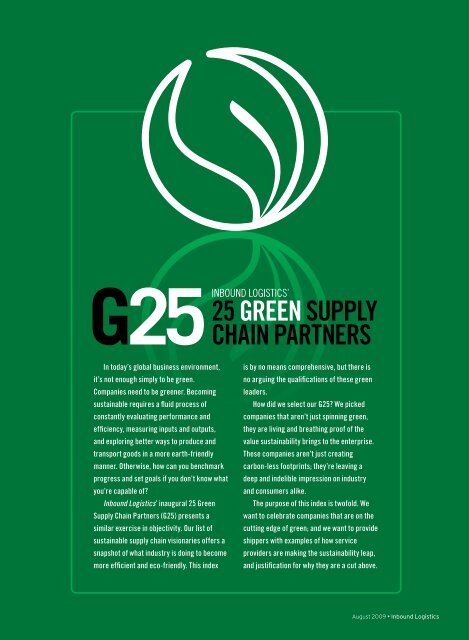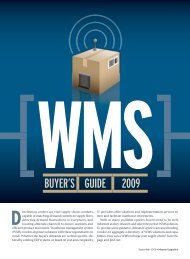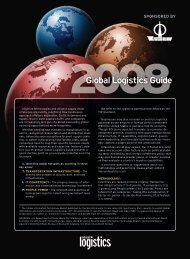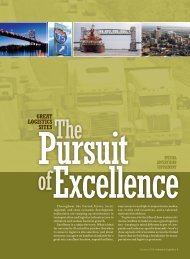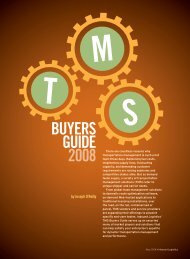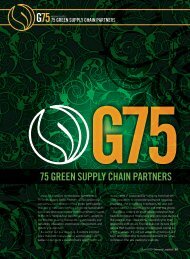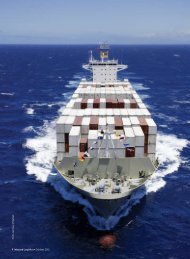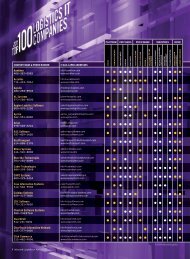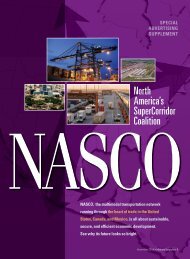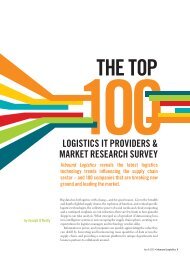25 Green Supply Chain Partners - Inbound Logistics
25 Green Supply Chain Partners - Inbound Logistics
25 Green Supply Chain Partners - Inbound Logistics
Create successful ePaper yourself
Turn your PDF publications into a flip-book with our unique Google optimized e-Paper software.
INBOUND LOGISTICS’<br />
<strong>25</strong> GREEN SUPPLY<br />
CHAIN PARTNERS<br />
In today’s global business environment,<br />
it’s not enough simply to be green.<br />
Companies need to be greener. Becoming<br />
sustainable requires a fluid process of<br />
constantly evaluating performance and<br />
efficiency, measuring inputs and outputs,<br />
and exploring better ways to produce and<br />
transport goods in a more earth-friendly<br />
manner. Otherwise, how can you benchmark<br />
progress and set goals if you don’t know what<br />
you’re capable of<br />
<strong>Inbound</strong> <strong>Logistics</strong>’ inaugural <strong>25</strong> <strong>Green</strong><br />
<strong>Supply</strong> <strong>Chain</strong> <strong>Partners</strong> (G<strong>25</strong>) presents a<br />
similar exercise in objectivity. Our list of<br />
sustainable supply chain visionaries offers a<br />
snapshot of what industry is doing to become<br />
more efficient and eco-friendly. This index<br />
is by no means comprehensive, but there is<br />
no arguing the qualifications of these green<br />
leaders.<br />
How did we select our G<strong>25</strong> We picked<br />
companies that aren’t just spinning green,<br />
they are living and breathing proof of the<br />
value sustainability brings to the enterprise.<br />
These companies aren’t just creating<br />
carbon-less footprints; they’re leaving a<br />
deep and indelible impression on industry<br />
and consumers alike.<br />
The purpose of this index is twofold. We<br />
want to celebrate companies that are on the<br />
cutting edge of green; and we want to provide<br />
shippers with examples of how service<br />
providers are making the sustainability leap,<br />
and justification for why they are a cut above.<br />
August 2009 • <strong>Inbound</strong> <strong>Logistics</strong>
2 0 0 9<br />
INBOUND LOGISTICS’<br />
<strong>25</strong> GREEN SUPPLY CHAIN PARTNERS<br />
UPS<br />
www.sustainability.ups.com<br />
Mission: UPS believes sound business practices<br />
and strategies can lead to a stronger, healthier<br />
environment. To that end, the company<br />
aggressively pursues technologies and processes<br />
that save energy and natural resources while<br />
reducing emissions and other waste products.<br />
Achievements: Selected to the 2008 Carbon<br />
Disclosure Leadership Index, released by the<br />
Carbon Disclosure Project. Also named to the<br />
Uptime Institute’s Global <strong>Green</strong> 100 List.<br />
BNSF Railway<br />
www.bnsf.com<br />
Mission: BNSF lives by the belief that it is good<br />
business and good citizenship to minimize its<br />
impact on the planet, and contribute to the longterm<br />
sustainability of every community it serves.<br />
Achievements: BNSF is the only U.S. railroad to<br />
join the Global Environmental Management<br />
Initiative, a non-profit organization of 40 leading<br />
U.S. companies dedicated to fostering global<br />
environmental health and safety excellence.<br />
Noteworthy: In 2007, BNSF became the first<br />
railroad to pilot the use of low-emission, naturalgas<br />
hostler trucks to move containers at its Los<br />
Angeles Hobart Intermodal facility. The 10 new<br />
hostlers reduce nitrogen oxide and particulate<br />
emissions by 90 percent.<br />
CSX<br />
www.csx.com<br />
Mission: “Safety and the protection of human<br />
health and the environment are fundamental to<br />
CSX’s management principles and good business<br />
practices,” says Michael J. Ward, chairman,<br />
president, and chief executive officer of CSX.<br />
Achievements: Since 2000, CSX has invested<br />
more than $1 billion to upgrade its fleet with<br />
efficient, Tier II clean air locomotives. By 2009,<br />
an additional 1,200 CSX locomotives will be<br />
upgraded to further reduce emissions and lower<br />
fuel consumption by nearly 10 million gallons.<br />
Noteworthy: CSX’s Environmental Crimes Unit<br />
(ECU) investigates and prosecutes environmental<br />
crimes conducted on company property. Since<br />
the ECU’s inception, 300 incidents have been<br />
investigated; there have been 14 arrests with a<br />
100-percent conviction record.<br />
Hybrid vehicle | UPS<br />
Noteworthy: UPS Worldport in Louisville, Ky., was<br />
designed to reduce the operation’s environmental<br />
impact. Worldport’s aircraft docks allow planes<br />
to park directly next to the facility, eliminating<br />
the need to run ground tugs, dollies, and other<br />
equipment required to load and unload aircraft<br />
parked on ramps.<br />
CHEP<br />
www.chep.com<br />
Mission: Pooling – the<br />
combining and sharing<br />
of assets in a common<br />
Pooled pallets | CHEP<br />
effort – is by definition<br />
an environmentally<br />
sustainable concept because it maximizes<br />
asset utilization. CHEP has pooled pallets and<br />
containers since 1958. That’s 51 years – and<br />
counting – of environmental stewardship.<br />
Achievements: CHEP was recently featured on an<br />
episode of the Discovery Channel’s Sustainable<br />
Planet’s Eye on the Environment series.<br />
Noteworthy: For <strong>25</strong> million CHEP pallets used<br />
annually at three trips each, an estimated 4.7<br />
billion pounds of waste is removed from the<br />
system. If pooled pallets were used for all oneway<br />
and exchange pallet trips, disposal of wood<br />
pallets by burning or landfill would decrease by<br />
6.1 million tons.<br />
NYK Line<br />
www.nyk.com<br />
Mission: More than 600 vessels operate in each<br />
of the seven oceans, day in and day out. It is<br />
impossible for NYK Line to complete its mission<br />
to be a successful logistics integrator without<br />
ensuring the safe transportation of its vessels<br />
and environmental protection.<br />
Achievements: NYK achieved a 10.8-percent<br />
reduction in CO 2<br />
emitted at its offices in fiscal<br />
2008, compared with the previous year. In 2009,<br />
the liner is aiming for a five-percent reduction<br />
through more efficient operation of head office<br />
facilities, such as optimizing air conditioning and<br />
continual CO 2<br />
reduction campaigns.<br />
Noteworthy: NYK is targeting the achievement of<br />
“zero emissions” by 2050 and has designed the<br />
concept vessel NYK Super Eco Ship 2030 as a<br />
milestone for meeting this objective.<br />
<strong>Inbound</strong> <strong>Logistics</strong> • August 2009
8-Series clean lift truck | Toyota<br />
American Airlines Cargo<br />
www.aacargo.com<br />
Mission: American Airlines is committed to<br />
complying with environmental laws and<br />
regulations; safeguarding the environment<br />
by adopting sustainable business practices,<br />
technologies, and procedures that take pollution<br />
prevention and conservation of natural resources<br />
into account; and establishing programs to<br />
communicate appropriate environmental<br />
information to all parties.<br />
Achievements: American claims to be the first U.S.<br />
carrier to test next-generation technology and<br />
procedures – dubbed the Atlantic Interoperability<br />
Initiative to Reduce Emissions (AIRE). The goal<br />
of AIRE – a joint initiative between the U.S.<br />
Federal Aviation Administration, the European<br />
Commission, and major airlines – is to reduce<br />
carbon emissions and fuel consumption.<br />
Noteworthy: American’s Fuel Smart program<br />
saves about 60 million to 70 million gallons of<br />
fuel each year.<br />
GENCO <strong>Supply</strong><br />
<strong>Chain</strong> Solutions<br />
www.genco.com<br />
Mission: To GENCO, creating a green supply chain<br />
means both adding more green to the bottom line<br />
and doing business in an earth-friendly manner.<br />
Achievements: GENCO has introduced a product<br />
liquidation solution called R-Log that maximizes<br />
the value of returned products through multiple<br />
liquidation channels. Depending on the<br />
customer’s priorities, GENCO offers a variety of<br />
green disposition methods, including returning<br />
product to the vendor for credit, online auctions,<br />
reselling into alternative channels, donating to<br />
charity, or disposal.<br />
Noteworthy: One of the easiest ways to green the<br />
supply chain is through reverse logistics. GENCO<br />
Marketplace offers product liquidation services<br />
that return unwanted, repaired, and refurbished<br />
merchandise back into the sales cycle.<br />
Toyota Material<br />
Handling USA<br />
www.toyotaforklift.com/<br />
environmental_focus/<br />
Mission: Toyota has made environmental<br />
accounting – a process that evaluates the<br />
effectiveness of environmental activities<br />
from the perspective of cost – a key aspect of<br />
corporate decision-making.<br />
Achievements: In 2006, Toyota introduced the<br />
8-Series line, the world’s cleanest internal<br />
combustion lift truck. The 8-Series features<br />
an exclusive emission system that not only<br />
surpasses 2007 federal EPA emission standards,<br />
but also meets California’s stringent 2010<br />
emission standards. The result: a lift truck<br />
that produces 70 percent less smog-forming<br />
emissions than the 2007 federal standard.<br />
Noteworthy: Toyota remains the only manufacturer<br />
to offer UL-listed, EPA, and CARB-certified<br />
Compressed Natural Gas-powered lift trucks.<br />
Energy-efficient vessel | Maersk<br />
Maersk Line<br />
www.maerskgreen.com<br />
Mission: Maersk Line is committed to developing<br />
environmentally friendly solutions to<br />
environmental and climate change challenges.<br />
Not only does this commitment offer a<br />
competitive edge to Maersk’s business, it also<br />
offers important benefits to the environment and<br />
climate.<br />
Achievements: From 2002 to 2007, Maersk<br />
reduced the average CO 2<br />
emissions for container<br />
transport by 8.9 percent. Last year alone, the<br />
decrease was approximately three percent.<br />
Noteworthy: Maersk’s Waste Heat Recovery<br />
System allows its vessels to save up to 10<br />
percent of fuel at optimum conditions. The liner<br />
has implemented the technology on 30 ships,<br />
and has plans for 38 more. Combined with other<br />
efforts, Maersk is looking to cut up to 20 percent<br />
of fuel costs, which in 2007 were $6 billion in the<br />
shipping business alone.<br />
August 2009 • <strong>Inbound</strong> <strong>Logistics</strong>
2 0 0 9<br />
INBOUND LOGISTICS’<br />
<strong>25</strong> GREEN SUPPLY CHAIN PARTNERS<br />
DB Schenker<br />
www.dbschenker.com<br />
Mission: Acting responsibly and reducing carbon<br />
dioxide and environmentally harmful emissions<br />
are the cornerstones of DB Schenker’s business<br />
strategy.<br />
Achievements: Between 1990 and 2007, DB<br />
Schenker reduced its specific rail transport<br />
carbon emissions – per passenger or ton of<br />
freight and kilometer – by nearly 40 percent. DB<br />
Schenker’s specific rail freight transport carbon<br />
emissions have dropped by 44 percent since 1990.<br />
Noteworthy: DB Schenker offers a carbonoptimized<br />
transport chain under the umbrella of<br />
the lighthouse project “<strong>Green</strong> <strong>Logistics</strong> Networks.”<br />
The aim is to reduce carbon emissions via an<br />
intelligent modal shift to less carbon-intensive<br />
transport modes, and by offering alternative<br />
transport services.<br />
Fuel-efficient trucks | DB Schenker<br />
C.H. Robinson<br />
www.chrobinson.com<br />
Mission: For C.H. Robinson, sustainability<br />
represents an overall approach to business – a<br />
way to add value, improve efficiencies, and invest<br />
in the long-term success of customers, contract<br />
carriers, growers, employees, and communities.<br />
Achievements: C.H. Robinson develops<br />
transportation and network optimization<br />
strategies for customers who realize savings<br />
through consolidation, resulting in fewer<br />
shipments and fewer transportation miles – with<br />
fewer greenhouse gas emissions.<br />
Noteworthy: C.H. Robinson’s proprietary Our World<br />
Organics brand donates a percentage of its net<br />
profits each year to organizations dedicated to<br />
sustainable initiatives.<br />
Low-emissions vehicle | YRC Worldwide<br />
YRC Worldwide<br />
www.yrcw.com/green/index.html<br />
Mission: The transportation providers of YRC<br />
Worldwide effectively and aggressively promote<br />
greenhouse gas reduction strategies, waste<br />
reduction, and conservation across their daily<br />
operations.<br />
Achievements: YRC limits truck speeds to 62/63<br />
mph, makes extensive use of intermodal service,<br />
set limits on daily idling with over-the-road and<br />
city operations, uses environmentally efficient<br />
longer combination vehicles where allowed, and<br />
practices an aggressive tire pressure inflation<br />
and monitoring program.<br />
Noteworthy: YRC estimates the strategies it<br />
deploys to increase fuel efficiency and decrease<br />
emissions result in a reduction of one million<br />
tons of CO 2<br />
annually.<br />
Con-way<br />
www.con-way.com<br />
Mission: Con-way’s goal is to make informed<br />
business decisions about sustainability that have<br />
a positive effect on the company, its operations,<br />
employees, and customers, while reducing its<br />
carbon footprint and improving the environment.<br />
Achievements: Con-way reduced the maximum<br />
governed speed of its 8,400-tractor fleet from 65<br />
mph to 62 mph. This action is expected to reduce<br />
consumption of diesel fuel by nearly 3.2 million<br />
gallons annually while eliminating approximately<br />
72 million pounds of carbon emissions.<br />
Noteworthy: Looking to the future, Con-way is<br />
implementing new recycling and waste reduction<br />
practices, has launched a major re-lamping<br />
project at its freight terminals to save electricity,<br />
and is piloting solar electric generating<br />
installations.<br />
<strong>Inbound</strong> <strong>Logistics</strong> • August 2009
Hub Group<br />
www.hubgroup.com<br />
Mission: Hub’s primary areas of environmental<br />
focus are centered around education awareness<br />
and goal development and measurement.<br />
Achievements: Hub Group was one of only three<br />
logistics companies to receive an Environmental<br />
Excellence Award from the U.S. Environmental<br />
Protection Agency SmartWay Transport<br />
<strong>Partners</strong>hip. The award cites Hub Group for<br />
its continued leadership in conserving energy<br />
and lowering greenhouse gas emissions in<br />
the environment through its transportation<br />
management activities.<br />
Noteworthy: Since 2006, Hub Group has increased<br />
its SmartWay carrier usage by 400 percent, from<br />
122 to 509. Hub also provides monthly updates<br />
to current vendors on methods for reducing their<br />
CO 2<br />
footprint.<br />
Fuel-saving lightweight container| Lufthansa<br />
Lufthansa Cargo<br />
www.lhcargo.com<br />
Mission: Striking a balance between economic<br />
interests and environmental responsibility<br />
remains Lufthansa’s guiding principle. This is<br />
well illustrated by the substantial investments<br />
the airline makes in its fuel-efficient fleet.<br />
Achievements: Since 1991, Lufthansa has provided<br />
50 percent of its additional transport services<br />
in a carbon-neutral manner. The airline’s future<br />
goals are ambitious: By 2020, it aims to reduce<br />
specific CO 2<br />
emissions by <strong>25</strong> percent compared<br />
to 2006 levels.<br />
Noteworthy: In February 2009, Lufthansa hosted<br />
its first Cargo Climate Care Award Conference in<br />
Frankfurt, Germany, to discuss green challenges<br />
and opportunities facing the transport industry.<br />
Werner Enterprises<br />
www.werner.com<br />
Mission: Werner Enterprises recognizes the<br />
important environmental role that transportation<br />
providers play in emission reductions. It is fully<br />
committed to investing in the technologies,<br />
strategies, and policies that increase fuel<br />
efficiency and decrease carbon footprints.<br />
Achievements: Through numerous sustainability<br />
initiatives and capital investments of more than<br />
$100 million in emission-reduction technologies,<br />
Werner is making great strides in improving fuel<br />
mileage and reducing emissions. As a result, the<br />
company purchased 12.4 million fewer gallons of<br />
diesel fuel during the last six quarters compared<br />
to 2007.<br />
Noteworthy: Werner is currently testing and<br />
implementing trailer skirting technology, which<br />
has helped improve fuel economy by 3.4 percent.<br />
FedEx<br />
www.fedex.com/us/promo/sustainability<br />
Mission: To minimize its impact on the<br />
environment, FedEx has initiated a number of<br />
conservation measures to reduce the amount<br />
of energy it uses daily. The company has also<br />
teamed up with other leading organizations to<br />
develop green technologies that ensure trucks<br />
and offices operate as efficiently as possible.<br />
Achievements: Teaming up with BP, FedEx Freight<br />
installed solar-electric systems in two service<br />
centers in California. Combined, these systems<br />
are expected to reduce annual CO2 emissions by<br />
610 metric tons, or the equivalent of more than<br />
69,000 gallons of gasoline.<br />
Noteworthy: FedEx Freight has worked in<br />
conjunction with the EnergyStar “Change the<br />
World” program to install energy-efficient<br />
lighting – including innovative LED lighting<br />
systems and compact fluorescent bulbs – in<br />
administrative offices and service centers across<br />
the country.<br />
Ryder<br />
www.ryder.com/aboutus_greenctr.shtml<br />
Mission: Ryder is committed to supporting<br />
sustainable development, environmental<br />
protection, and pollution prevention in its global<br />
business.<br />
Achievements: Ryder recycled more than 3,800 tons<br />
of office paper and cardboard in 2008. Avoiding<br />
their manufacturing and disposal resulted in<br />
Energy Star building in Novi, Mich. | Ryder<br />
a total reduction of more than 2,600 tons of<br />
greenhouse gas emissions.<br />
Noteworthy: Ryder performs remote monitoring<br />
at more than 400 locations, and compliance<br />
management for more than 1,800 storage<br />
tanks, 24 hours a day, 365 days a year through<br />
wholly owned subsidiary Ryder Fuel Compliance<br />
Services.<br />
August 2009 • <strong>Inbound</strong> <strong>Logistics</strong>
2 0 0 9<br />
INBOUND LOGISTICS’<br />
<strong>25</strong> GREEN SUPPLY CHAIN PARTNERS<br />
Swift Transportation<br />
www.swifttrans.com<br />
Mission: Swift is dedicated to running one of the<br />
most fuel-efficient truckload fleets in the United<br />
States.<br />
Achievements: Two-time SmartWay Excellence<br />
Award recipient Swift Transportation employs the<br />
latest technology to reduce the carbon footprint<br />
of its 1,000-tractor Clean Fleet. Utilizing 2009<br />
tractors, the fleet is fully exempt from port dirty<br />
truck fees, cutting costs for shippers.<br />
Noteworthy: The carrier uses special software to<br />
track miles per gallon and idling rates, holding<br />
every level of the organization accountable<br />
for performance improvements. This tracking<br />
program has led to a 30-percent reduction in<br />
idling time fleet-wide. Innovative extra cab<br />
fairings, high-tech tracking of trailers to reduce<br />
empty miles, and driver training and incentives<br />
saved more than 1.8 million tons of CO 2<br />
in 2007.<br />
Schneider National<br />
www.schneider.com/sustainability/index.htm<br />
Mission: At the heart of Schneider National’s<br />
daily decision-making process is the belief that<br />
environmental sustainability, conservation, and<br />
protection, along with community advancement,<br />
can only be achieved by sustained economic<br />
progress.<br />
Achievements: Schneider began focusing on<br />
energy efficiency in 1978 when it pioneered<br />
driver incentives for idle reduction and fuel<br />
management. The program evolved in 1985<br />
when Schneider included performance metrics<br />
Energy-efficient trucks | Schneider<br />
and driver compensation incentives based on<br />
their ability to more effectively manage fuel<br />
consumption.<br />
Noteworthy: Schneider’s corporate office in <strong>Green</strong><br />
Bay, Wis., and 210 facilities around the world<br />
are designed to maximize energy efficiency.<br />
Schneider’s headquarters are cooled using an<br />
eco-friendly ice storage system, which reduces<br />
energy needs during peak consumption hours.<br />
The system cuts energy use by 30 percent and<br />
helps prolong the need for incremental power<br />
plant construction in Northeast Wisconsin.<br />
TransGroup Worldwide<br />
<strong>Logistics</strong><br />
www.transgroup.com<br />
Mission: TransGroup continually enhances its<br />
green initiatives by adding asset recovery and<br />
disposition services, as well as providing carbon<br />
footprint metrics.<br />
Achievements: TransGroup’s Asset Recovery and<br />
Reverse <strong>Logistics</strong> service helps companies go<br />
green by managing the recovery and proper<br />
disposition of equipment and other value assets<br />
that have reached their end-of-lease or product<br />
lifecycles.<br />
Noteworthy: The company’s TransNeutral<br />
opt-in program enables users to “green” their<br />
shipments and make a positive difference in<br />
the collective environment with every pound<br />
shipped. For every ton of CO 2<br />
a TransNeutral<br />
shipment produces, another ton is taken away, or<br />
prevented – permanently and transparently.<br />
Wind turbine transport | TransGroup<br />
<strong>Inbound</strong> <strong>Logistics</strong> • August 2009
The Port of Long Beach<br />
www.polb.com<br />
Mission: Guided by its award-winning <strong>Green</strong><br />
Port Policy, the Port of Long Beach is reducing<br />
harmful air emissions from port-related<br />
operations, improving water quality in the harbor,<br />
protecting marine wildlife, and implementing<br />
environmentally sustainable practices throughout<br />
its facilities.<br />
Achievements: The Port of Long Beach has<br />
launched a Clean Trucks Program that will reduce<br />
air pollution from harbor trucks by more than 80<br />
percent by 2012.<br />
Noteworthy: The ports of Long Beach and Los<br />
Angeles have joined to adopt the San Pedro Bay<br />
Ports Clean Air Action Plan, a sweeping program<br />
aimed at significantly reducing the health risks<br />
posed by air pollution from port-related ships,<br />
trains, trucks, terminal equipment, and harbor<br />
craft.<br />
Hybrid tug | Port of Long Beach<br />
Sealed Air<br />
www.sealedair.com<br />
Mission: Sealed Air focuses on more efficiently<br />
managing natural resources and the impact its<br />
products have on the environment.<br />
Achievements: In 2008 alone, the packaging<br />
company proved its “greenness”: Its package<br />
and design labs removed two million pounds of<br />
excess packaging, it introduced an improved<br />
line of high-performance shrink films that are<br />
20 percent thinner, and it developed a new Jiffy<br />
Mailer product made from 100-percent recycled<br />
newspapers and kraft material.<br />
Noteworthy: Sealed Air is looking to reduce<br />
greenhouse gas emissions by 12 percent between<br />
2006 and 2010.<br />
Intermodal stack train | Norfolk Southern<br />
Norfolk Southern<br />
www.nscorp.com/footprints<br />
Mission: Norfolk Southern is committed to<br />
protecting the quality of the environment. The<br />
rail’s Environmental Protection Department<br />
and Environmental Policy Council ensure that<br />
appropriate policies, procedures, and resources<br />
are in place to address environmental health and<br />
safety concerns across the system.<br />
Achievements: Norfolk Southern is investing more<br />
than $100 million to upgrade its locomotive<br />
fleet. The company leads the rail industry with 73<br />
percent of its locomotives already compliant with<br />
EPA emissions standards.<br />
Noteworthy: The railroad’s <strong>Green</strong> Machine, a<br />
carbon footprint analyzer, allows businesses to<br />
estimate the emissions savings of choosing rail<br />
over other transportation modes.<br />
The Port of Seattle<br />
www.portseattle.org/community/<br />
environment/<br />
Mission: The Port of Seattle aims to be the<br />
cleanest, greenest, and most energy-efficient<br />
port in the nation.<br />
Achievements: One example of the Port’s<br />
environmental record is its Pier 66 project.<br />
When the pier was redeveloped as a public-use<br />
area, concrete pilings replaced creosote-treated<br />
wooden ones and the structure was designed to<br />
provide more light and corridor improvements<br />
for salmon and other sea life. The project was<br />
awarded an Environmental Improvement Award<br />
from the American Association of Port Authorities.<br />
Noteworthy: The Port of Seattle and the Port of<br />
Dalian, China, have agreed to work with other<br />
public and private sector companies on an<br />
Eco<strong>Partners</strong>hip to advance environmental and<br />
economic sustainability.<br />
August 2009 • <strong>Inbound</strong> <strong>Logistics</strong>


